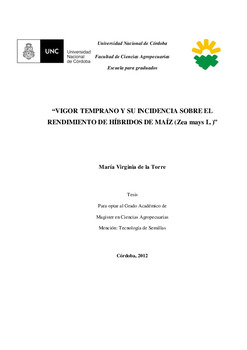| dc.contributor.advisor | Biasutti, Carlos Alberto | |
| dc.contributor.author | de la Torre, María Virginia | |
| dc.date.accessioned | 2014-12-16T19:05:50Z | |
| dc.date.available | 2014-12-16T19:05:50Z | |
| dc.date.issued | 2012 | |
| dc.identifier.uri | http://hdl.handle.net/11086/1670 | |
| dc.description | Tesis (Magister en Ciencias Agropecuarias. Mención: Tecnología de Semillas)--UNC- Facultad de Ciencias Agropecuarias, 2012. | es |
| dc.description.abstract | El vigor temprano es considerado un componente esencial del desarrollo de los cultivos en la mayoría de las condiciones ambientales. Este término se utiliza para definir una prueba a laboratorio o también denominado vigor temprano a campo. El vigor está representado por el porcentaje de semillas que germinan bajo condiciones limitantes, diferenciándose del ensayo de germinación en condiciones óptimas. Las pruebas estándares de vigor en maíz no necesariamente predicen el comportamiento a campo y no existe aún suficiente información sobre los efectos de aptitud combinatoria y recíprocos para pruebas de vigor en laboratorio, como tampoco a campo. El objetivo fue establecer la influencia del vigor temprano y sus efectos génicos sobre el rendimiento de híbridos de maíz. Se utilizaron 20 híbridos simples de maíz provenientes de la cruza dialélica de 5 líneas endocriadas incluyendo recíprocos. Los ensayos a laboratorio incluyeron un test de Osmolitos, donde el estrés hídrico se simuló mediante solución de PEG 8000 al -1,4 MPa. Se midió el Poder Germinativo, la Longitud de parte aérea, la Longitud de raíz y el Peso Seco. La evaluación a campo consistió en una siembra temprana en secano, donde se evaluó: EAC1 Y 2, V1 Y 2, ALT1 Y 2, PSPTA, IV1 Y 2, EF Y RTO. Los resultados no evidenciaron relaciones directas entre el RTO y las variables de vigor bajo estrés hídrico evaluadas en laboratorio, indicando que el ensayo de vigor en PEG no demostró utilidad para estimar la producción de granos en los híbridos. Para las variables asociadas al vigor temprano a campo, se pudo detectar que sólo la altura de planta a los 23 días desde la siembra (ALT1) presentó correlación positiva con el RTO y, por lo tanto, resultó ser la única variable predictiva del rendimiento. El análisis genético mostró la importancia de los efectos no aditivos en el conjunto de variables de vigor evaluadas en condiciones de campo, a diferencia de los ensayos de estrés en laboratorio donde la expresión de los caracteres estuvo gobernada predominantemente por efectos de aditividad. En particular, la ALT1 estuvo condicionada por efectos de aditividad y de dominancia, por lo que esta variable puede ser evaluada durante la endocría como así también entre los híbridos. Los efectos recíprocos fueron importantes para la totalidad de las variables, incluyendo a la ALT1, lo cual indica la necesidad de determinar las líneas maternas con alta expresión para las variables evaluadas para contribuir a incrementar los rendimientos en grano. | es |
| dc.description.abstract | The early vigor is considered to be an essential component of the development of crops in most environmental conditions. This term is used to define as well a laboratory test and what is also called field early vigor. The vigor is represented by the percentage of seeds that germinate under limiting conditions, differentiating from the germination test in optimal conditions. Standards testing of vigor in maize do not necessarily predict the field performance and there is still insufficient information on the effects of combining ability and reciprocal effects in laboratory tests, nor in its field evaluation. The aim was to establish the influence of the early vigor and its gene effects on the performance of hybrid corn. Five maize inbred lines were crossed to obtain twenty single crosses including reciprocals. Crosses were evaluated under controlled laboratory conditions in polyethylene glycol 8000 (PEG) solution at 1.4MPa. Data of the following characters were recorded: germination percentage under drought, coleoptiles length, root length and dry weight. Single crosses were evaluated at field in a RCBD, attending: Plant field emergence 1 and 2, Vigor 1 and 2, Plant height 1 and 2, Dry plant weight, vigor index 1 and 2, foliar elongation and grain yield. No direct relations were found between grain yield and vigor under water stress characters evaluated in laboratory, indicating that the vigor in PEG trial was not helpful to predict grain yield production. For the variables associated with field early vigor, only plant height at 23 days from sowing presented positive correlation with grain yield and, therefore, turned out to be the most predictable of field grain yield. Genetic analysis showed the importance of non-aditive genetic effects among of variables related to vigor evaluated in field conditions, unlike stress testing in the laboratory where the expression of the character was predominantly ruled by additive effects. The ALT1 was conditioned both by additive and dominance effects, so that it may be evaluated during inbreeding as well as among single crosses. Reciprocal effects were important for all variables, including ALT1, making necessary to determine the maternal lines that will contribute to increase grain yields. | en |
| dc.format.extent | 103 h. : ilustración | |
| dc.language.iso | spa | es |
| dc.rights | Atribución-NoComercial-SinDerivadas 2.5 Argentina | * |
| dc.rights.uri | http://creativecommons.org/licenses/by-nc-nd/2.5/ar/ | * |
| dc.subject | Maíz | es |
| dc.subject | Zea Mays | es |
| dc.subject | Viabilidad de la semilla | es |
| dc.subject | Rendimiento | es |
| dc.subject | Híbridos | es |
| dc.subject | Fitomejoramiento | es |
| dc.title | Vigor temprano y su incidencia sobre el rendimiento de híbridos de maíz (Zea mays L.) | es |
| dc.type | masterThesis | es |





